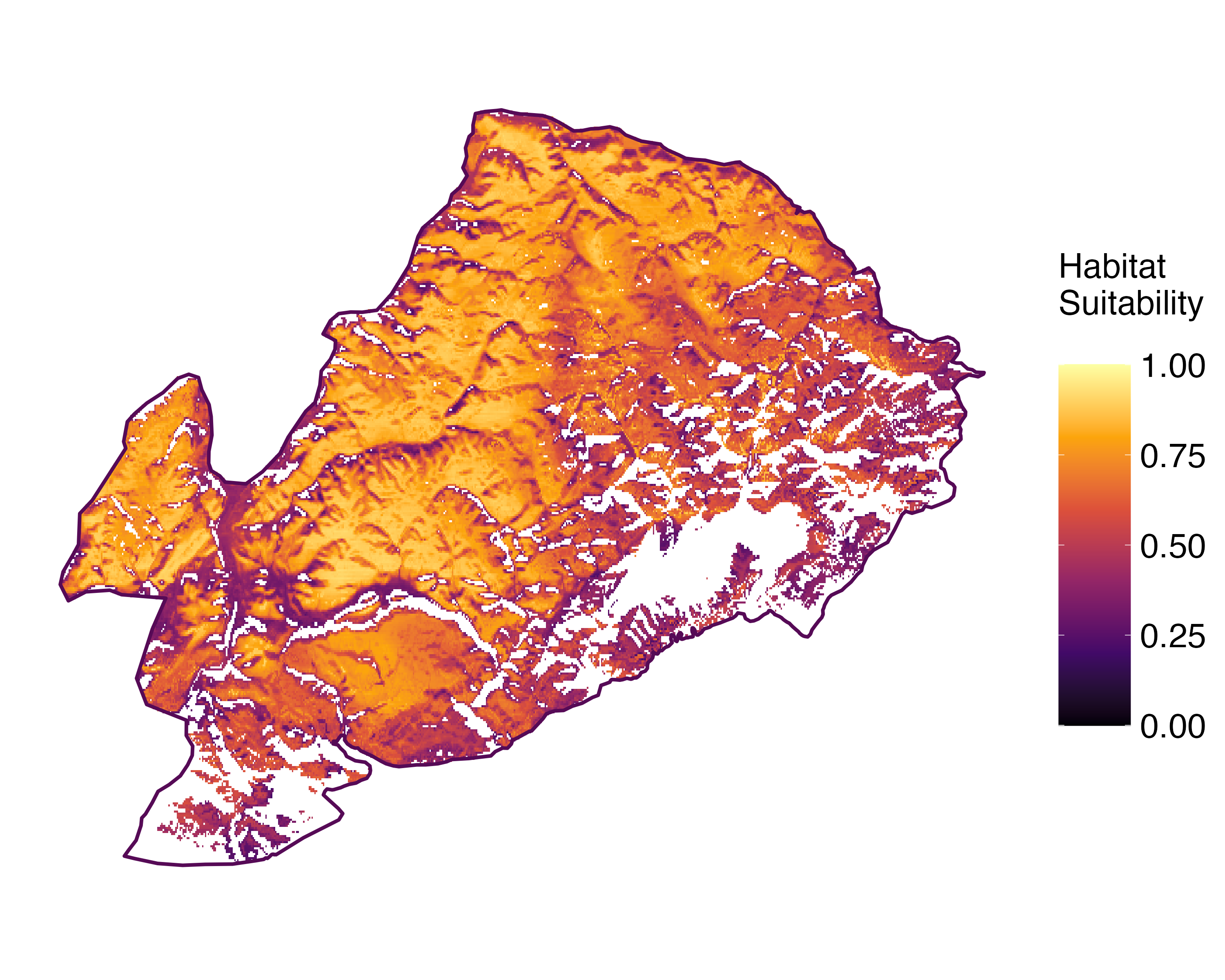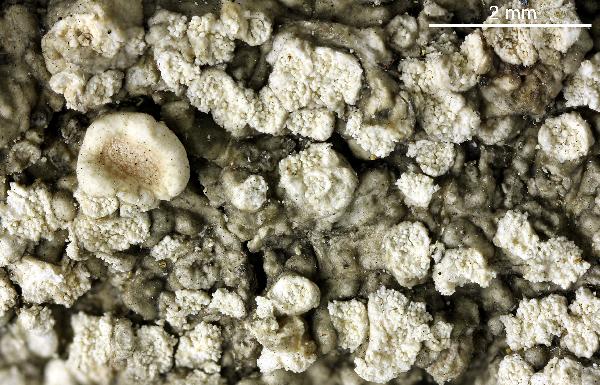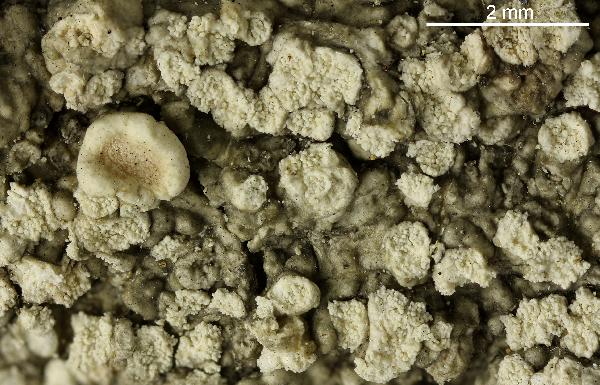Ochrolechia alboflavescens (Wulfen) Zahlbr.
Verh. zool.-bot. Ges. Wien, 76: 94, 1927. Basionym: Lichen alboflavescens Wulfen in Jacquin - Coll. Bot., 3: 111, 1789.
Synonyms: Lecanora tartarea var. alboflavescens (Wulfen) Flot.; Ochrolechia alboflavescens f. subfarinosa Verseghy; Ochrolechia alboflavescens var. plana Verseghy; Ochrolechia papillata (Räsänen) Verseghy; Ochrolechia parella f. papillata Räsänen; Ochrolechia parella var. alboflavescens (Wulfen) Arnold; Ochrolechia tartarea var. alboflavescens (Wulfen) A. Massal.
Description: Thallus crustose, episubstratic, 0.3-0.5 mm thick, continuous to rimose or verruculose but not areolate, whitish, cream-coloured, yellow-grey to brown-grey, without a distinct prothallus, sorediate. Soralia usually well-delimited, rounded or rarely irregular, flat to crateriform and then with a distinct thalline rim, rarely convex, 1-2 mm wide, grey to white, the soredia granular, to 150 μm across. Apothecia rather common, lecanorine, 1-3(-4) mm across, with a pinkish brown to brown, sometimes scabrid, usually pruinose, concave to flat disc and a smooth or rarely flexuose, epruinose, sometimes partly sorediate thalline margin. Thalline exciple corticate, the cortex well-developed,
50–75 µm thick; proper exciple weakly developed, not spreading over the
thalline margin; epithecium brownish, C+ and KC+ red; hymenium colourless; paraphyses thin, slender, densely branched and anastomosing; hypothecium colourless, subtended by algae in irregular groups or forming a continuous layer. Asci 2-4-(8-)spored, with thick, amyloid walls, without recognizable apical structures, Pertusaria-like. Ascospores 1-celled, hyaline, ellipsoid, (25-)30-57 x (10-)20-38 µm. Photobiont chlorococcoid. Spot tests: thallus (incl. soredia) K-, C+ yellow, P-; medulla C-. Chemistry: thallus with variolaric acid (major), lichesterinic acid (major), protolichesterinic acid, sometimes with an unknown substance (minor or traces); epithecium with gyrophoric acid (major to minor) and lecanoric acid (minor to trace).
Growth form: Crustose
Substrata: bark
Photobiont: green algae other than Trentepohlia
Reproductive strategy: mainly asexual, by soredia, or soredia-like structures (e.g. blastidia)
Commonnes-rarity: (info)
Alpine belt: absent
Subalpine belt: common
Montane belt: very rare
Dry submediterranean belt: absent
Humid submediterranean belt: absent
Padanian area: absent
pH of the substrata:
1 2 3 4 5
Solar irradiation:
1 2 3 4 5
Aridity:
1 2 3 4 5
Eutrophication:
1 2 3 4 5
Poleotolerance:
0 1 2 3
Altitudinal distribution:
1 2 3 4 5 6
Rarity
absent
extremely rare
very rare
rare
rather rare
rather common
common
very common
extremely common
Loading data...
Occurrence data
Predictive map
 Current prediction (1981-2010)
Current prediction (1981-2010) Future prediction (2071-2100) SSP 1-2.6
Future prediction (2071-2100) SSP 1-2.6 Future prediction (2071-2100) SSP 5-8.5Predictive maps according to Francesconi et al. 2025
Future prediction (2071-2100) SSP 5-8.5Predictive maps according to Francesconi et al. 2025
P.L. Nimis; Owner: Department of Life Sciences, University of Trieste
Herbarium: TSB (17930)
2001/12/10
soralia

P.L. Nimis; Owner: Department of Life Sciences, University of Trieste
Herbarium: TSB (17930)
2001/12/10

P.L.Nimis; Owner: Department of Life Sciences, University of Trieste
Herbarium: TSB (37096)
2008.02.28

Juri Nascimbene - CC BY-SA 4.0
Stelvio National Park, Reg. Trentino-Alto Adige Prov. Trento, Italy.
07.2005

Walter Obermayer CC BY-SA 4.0 - Source: Lichens of Noricum - http://lichens-of-noricum.uni-graz.at/
Winterlhuette Rodelbahn; altitude: Austria

Walter Obermayer CC BY-SA 4.0 - Source: Lichens of Noricum - http://lichens-of-noricum.uni-graz.at/
Winterlhuette Rodelbahn; altitude: Austria

Walter Obermayer CC BY-SA 4.0 - Source: Lichens of Noricum - http://lichens-of-noricum.uni-graz.at/
Winterlhuette Rodelbahn; altitude: Austria

Ulrich Kirschbaum CC BY-SA 4.0 – Source: https://www.thm.de/lse/ulrich-kirschbaum/flechtenbilder
Austria: Alps.
Growth form: Crustose
Substrata: bark
Photobiont: green algae other than Trentepohlia
Reproductive strategy: mainly asexual, by soredia, or soredia-like structures (e.g. blastidia)
Commonnes-rarity: (info)
Alpine belt: absent
Subalpine belt: common
Montane belt: very rare
Dry submediterranean belt: absent
Humid submediterranean belt: absent
Padanian area: absent
pH of the substrata:
| 1 | 2 | 3 | 4 | 5 |
Solar irradiation:
| 1 | 2 | 3 | 4 | 5 |
Aridity:
| 1 | 2 | 3 | 4 | 5 |
Eutrophication:
| 1 | 2 | 3 | 4 | 5 |
Poleotolerance:
| 0 | 1 | 2 | 3 |
Altitudinal distribution:
| 1 | 2 | 3 | 4 | 5 | 6 |
Rarity
absent
extremely rare
very rare
rare
rather rare
rather common
common
very common
extremely common
Loading data...
Occurrence data
Predictive map
 Current prediction (1981-2010)
Current prediction (1981-2010) Future prediction (2071-2100) SSP 1-2.6
Future prediction (2071-2100) SSP 1-2.6 Future prediction (2071-2100) SSP 5-8.5
Future prediction (2071-2100) SSP 5-8.5Predictive maps according to Francesconi et al. 2025

P.L. Nimis; Owner: Department of Life Sciences, University of Trieste
Herbarium: TSB (17930)
2001/12/10
soralia

P.L. Nimis; Owner: Department of Life Sciences, University of Trieste
Herbarium: TSB (17930)
2001/12/10

P.L.Nimis; Owner: Department of Life Sciences, University of Trieste
Herbarium: TSB (37096)
2008.02.28

Juri Nascimbene - CC BY-SA 4.0
Stelvio National Park, Reg. Trentino-Alto Adige Prov. Trento, Italy.
07.2005

Walter Obermayer CC BY-SA 4.0 - Source: Lichens of Noricum - http://lichens-of-noricum.uni-graz.at/
Winterlhuette Rodelbahn; altitude: Austria

Walter Obermayer CC BY-SA 4.0 - Source: Lichens of Noricum - http://lichens-of-noricum.uni-graz.at/
Winterlhuette Rodelbahn; altitude: Austria

Walter Obermayer CC BY-SA 4.0 - Source: Lichens of Noricum - http://lichens-of-noricum.uni-graz.at/
Winterlhuette Rodelbahn; altitude: Austria
















